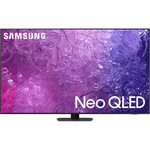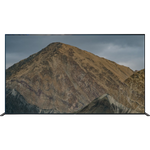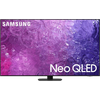A comparison of specs, key information, reviews, and best pricing from top retailers
Last updated -- hours ago | Report incorrect information
What we think

The PerfectRec TV team Learn more
Updated January 10, 2024·
Choosing between the Samsung QN90C and the Sony A90J requires considering a few factors. The Samsung QN90C, being less expensive, offers an excellent bright room performance and competitive gaming features. If you're on a budget, prefer gaming, and have a well-lit room, this could be a solid choice. Conversely, the Sony A90J, while more expensive, excels in picture quality, especially in dark rooms, and provides a superior movie-watching experience. If you're willing to invest more for top-tier movies and TV series viewing, particularly in darker rooms, the A90J might be better for you. Give Feedback
this description is based on the product variant with some specs and product variant with some specs. At the time of writing, the variant with some specs cost some dollars and the variant with some specs cost some dollars.
Advantages of the Samsung QN90C (LCD)
- Best in class for bright room
Advantages of the Sony A90J (OLED)
- Excellent for dark room
- Excellent for movies & TV
- Excellent for sports
- Best in class for upscaling
- Best in class motion processing
- Very good viewing angle
Key differences
Picture Quality
8.1


8.7
7.38/10
CONTRAST
10.00/10
9.1/10
COLOR VOLUME SCORE
7.4/10
miniLED FALD
PANEL TYPE
WOLED
ADS / IPS
PANEL SUB-TYPE
WBE
The Sony A90J (OLED) and Samsung QN90C (LCD) both have very good picture quality, though the Sony A90J (OLED) has somewhat better picture quality.
Movies & TV
8.0


9.1
7.38/10
CONTRAST
10.00/10
6.8/10
BLACK UNIFORMITY
10.0/10
8.0/10
UPSCALING
10.0/10
Yes
HDR10 SUPPORT
Yes
Yes
HDR10+ SUPPORT
No
No
DOLBY VISION SUPPORT
Yes
The Sony A90J (OLED) is excellent for movies & TV, while the Samsung QN90C (LCD) is very good.
The Sony A90J (OLED) offers perfect black uniformity and contrast, with excellent viewing angles that enhance movies and cinematic TV, especially in darker environments. On the other hand, the Samsung QN90C (LCD) provides very good contrast and local dimming that work well for bright rooms, but its black uniformity and viewing angles are not as superior as the OLED, which might affect viewing in low-light conditions.
Sports
7.0


9.2
8.0/10
MOTION PROCESSING
10.0/10
120Hz
REFRESH RATE
120Hz
10.0/10
INPUT LAG SCORE
7.3/10
8.0/10
UPSCALING
10.0/10
10.0/10
SDR BRIGHTNESS SCORE
7.0/10
Yes
HLG SUPPORT
Yes
The Sony A90J (OLED) is excellent for sports, while the Samsung QN90C (LCD) is good.
The Samsung QN90C has a good response time and motion processing for sports but less optimal viewing angles and gray uniformity compared to the Sony A90J, which offers excellent response time and motion processing alongside better viewing angles and gray uniformity, making it superior for watching sports.
Gaming
8.2


8.8
7.8/10
RESPONSE TIME SCORE
9.4/10
10.0/10
INPUT LAG SCORE
7.3/10
8.0/10
MOTION PROCESSING
10.0/10
75.0/100
GAMING LOCAL DIMMING
100.0/100
8.9/10
GAME HDR BRIGHTNESS SCORE
7.5/10
The Sony A90J (OLED) and Samsung QN90C (LCD) are both very good for gaming, though the Sony A90J (OLED) is somewhat better.
The Samsung QN90C offers exceptional input lag performance, suitable for competitive gaming, while the Sony A90J delivers an excellent response time, beneficial for fast-moving visuals without blur. Both TVs support a high refresh rate which enhances smooth motion clarity, ideal for gaming experiences.
Bright Room
9.7


7.3
6.5/10
VIEWING ANGLE
8.5/10
10.0/10
SDR BRIGHTNESS SCORE
7.0/10
8.8/10
HDR BRIGHTNESS SCORE
7.4/10
9.0/10
REFLECTIONS SCORE
9.2/10
The Samsung QN90C (LCD) is best in class for bright room, while the Sony A90J (OLED) is good.
The Samsung QN90C's superior SDR and HDR brightness make it a better choice for a brightly lit room than the Sony A90J, and both handle reflections excellently. While the A90J, an OLED TV known for outstanding contrast and color volume, sports a wider color gamut, the QN90C, with its LCD tech and substantial brightness, ensures vibrant colors and clear visuals even in bright conditions.
Cost
$1,299


$2,498
$500
$1,000
$1,500
$2,000
$2,500
$3,000
$3,500
$4,000
The Samsung QN90C (LCD) has a price of $1,299 and the Sony A90J (OLED) costs $2,498.

Let Us Help Find Your Perfect TV
Find your new TV
Key similarities
Cartoons & Animation
8.8


8.5
7.5/10
COLOR GAMUT SCORE
7.8/10
9.1/10
COLOR VOLUME SCORE
7.4/10
10.0/10
SDR BRIGHTNESS SCORE
7.0/10
8.1/10
COLORS OUT OF THE BOX SCORE
8.3/10
7.7/10
GRAY UNIFORMITY
9.8/10
The Samsung QN90C (LCD) and Sony A90J (OLED) are both very good for cartoons & animation.
The Samsung QN90C excels in displaying cartoons and animation with very good colors right out of the box, alongside a good color gamut and color volume which ensures vibrant colors across different brightness levels. The Sony A90J also delivers very good color accuracy for animated content with its wide color gamut and good color volume, with the added advantage of an OLED panel that provides deeper contrasts and high gray uniformity, enhancing the overall picture quality.
News, Talk, & Other TV
8.8


8.9
10.0/10
SDR BRIGHTNESS SCORE
7.0/10
8.0/10
UPSCALING
10.0/10
The Sony A90J (OLED) and Samsung QN90C (LCD) are both very good for news, talk, & other TV.
The Samsung QN90C's high SDR brightness and effective upscaling make it well-suited for viewing in bright rooms and enhancing lower-resolution content like standard TV programming. On the other hand, the Sony A90J offers superior contrast and impressive color capabilities, which enhance the viewing experience of news and talk shows by providing more vivid and lifelike images.
Give feedback
We’re constantly working to improve.
How the Samsung QN90C (LCD) and the Sony A90J (OLED) compare to other TVs
Spec Comparison
| Samsung QN90C (LCD) | Sony A90J (OLED) |
GENERAL | |||
|---|---|---|---|
| Price | |||
$1,299 | $2,498 | ||
Brand | |||
Brand | Samsung | Sony | |
Release Date | |||
Release Date | March 2, 2023 | March 2, 2021 | |
Full name | |||
Full name | QN65QN90C | XR-65A90J | |
Screen Size | |||
Screen Size | 65" | 65" | |
Screen Resolution | |||
Screen Resolution | 4K | 4K | |
TV FEATURES | |||
|---|---|---|---|
Operating System | |||
Operating System | Tizen | Android TV | |
Sound Quality Score | |||
Sound Quality Score | 8.3/10 | 8.9/10 | |
NextGen Ready | |||
NextGen Ready | Yes | Yes | |
HDMI Ports | |||
HDMI Ports | 4 | 4 | |
Coax Ports | |||
Coax Ports | 1 | 1 | |
DISPLAY QUALITY SCORES | |||
|---|---|---|---|
Picture Quality Score | |||
Picture Quality Score | 8.1/10 | 8.8/10 | |
Bright Room Score | |||
Bright Room Score | 9.7/10 | 7.3/10 | |
Gaming Score | |||
Gaming Score | 8.3/10 | 8.9/10 | |
Movies & TV Score | |||
Movies & TV Score | 8.1/10 | 9.2/10 | |
Sports Score | |||
Sports Score | 7/10 | 9.2/10 | |
PHYSICAL | |||
|---|---|---|---|
Dimensions w/o Stand (H x W x D) | |||
Dimensions w/o Stand (H x W x D) | 32.6" x 56.9" x 1.1" | 32.8" x 56.8" x 1.6" | |
Dimensions with Stand (H x W) | |||
Dimensions with Stand (H x W) | 35.1" x 56.9" | 32.8" x 59.1" | |
Weight without Stand | |||
Weight without Stand | 53.4 lbs | 49.6 lbs | |
VESA Mount | |||
VESA Mount | 400 x 400 | 300 x 300 | |
DISPLAY | |||
|---|---|---|---|
Color Depth | |||
Color Depth | 10 bit | 10 bit | |
Black Frame Insertion | |||
Black Frame Insertion | Yes | Yes | |
Auto Low Latency Mode | |||
Auto Low Latency Mode | Yes | Yes | |
Contrast | |||
Contrast | 7.4/10 | 10/10 | |
Local Dimming | |||
Local Dimming | 7/10 | 10/10 | |
SOUND | |||
|---|---|---|---|
Speaker Setup | |||
Speaker Setup | 4.2.2 | 2.2 | |
Speaker Power | |||
Speaker Power | 60 W | 60 W | |
Dolby Atmos | |||
Dolby Atmos | Yes | Yes | |
DTS:X | |||
DTS:X | No | Up to DTS Digital Surround, Bypass only | |
Shopping
Sony A90J (OLED)
See more
Dig into reviews and images
Techradar
Simon Lucas | June 2021
"In every meaningful department – motion control, contrast, edge definition, detail levels, you name it the A90J puts in a memorably accomplished shift. In fact, the Sony proves outstanding at handling on-screen motion of any and every kind. By the standards of television audio systems, the A90J is a notably punchy and genuinely dynamic performer."
Get a great deal on the Samsung QN90C (LCD) or the Sony A90J (OLED)
About Samsung
Samsung, a South Korean electronics manufacturer, holds the title of being the largest global TV vendor in terms of units sold. They offer a diverse lineup of TV products that cater to various budget ranges. A notable achievement in recent years is the development of Quantum Dots, a technology that enhances color reproduction, resulting in richer and more vibrant hues. Samsung TVs are well-regarded for their high manufacturing quality and user-friendly software, making them an excellent choice for consumers seeking an intuitive viewing experience.
About Sony
Sony stands as a highly experienced and widely trusted TV manufacturer, earning a reputation that surpasses all others. A Japanese company, Sony has been making TVs for far longs than it has been making Playstation game consoles. Sony's high-end TVs are often regarded as the ultimate choice for videophiles, representing the epitome of quality, albeit at a premium price point. Renowned for their advanced and precise motion handling, as well as their cutting-edge local dimming algorithms, Sony consistently delivers unparalleled performance in these areas. They include Google TV software with all their TV sets, which grants access to the largest selection of apps available and they also include Bravia Core which is a movie streaming platform specifically for Sony TVs that offers higher picture quality by using more bandwidth.
Give feedback
We're constantly perfecting our model
TV guides you might be interested in
More comparisons for you
FAQs
FAQs about TVs
Why trust us
This information was produced and vetted by the PerfectRec TVs team. We are a product research and recommendation organization that meticulously reviews and evaluates the latest TV information and makes it digestible for you.
By the numbers
385
TVs evaluated
33,110
TVs stats compiled
21
Proprietary TVs ratings developed
122,430
Recommendations made
18,365
Consumer hours saved
About the TV team
Joe Golden, Ph.D
CEO and TVs Editor
Joe is an entrepreneur and lifelong electronics enthusiast with a Ph.D in Economics from the University of Michigan.
Jason Lew
Staff Expert & Software Engineer
Jason is a staff expert and software engineer that has been making laptop recommendations for 7 years and moderates one of the largest laptop subreddits.
Chandradeep Chowdhury
Staff Expert & Software Engineer
Chandradeep is a staff expert and software engineer and expert in televisions and monitors. He’s been making monitor recommendations for ten years.
Jaime Roldán
TVs Expert
Jaime is a Colombia-based TV expert. He is an electronics engineer with 8 years of experience in the telecom sector and has been making TV recommendations for 12 years.







